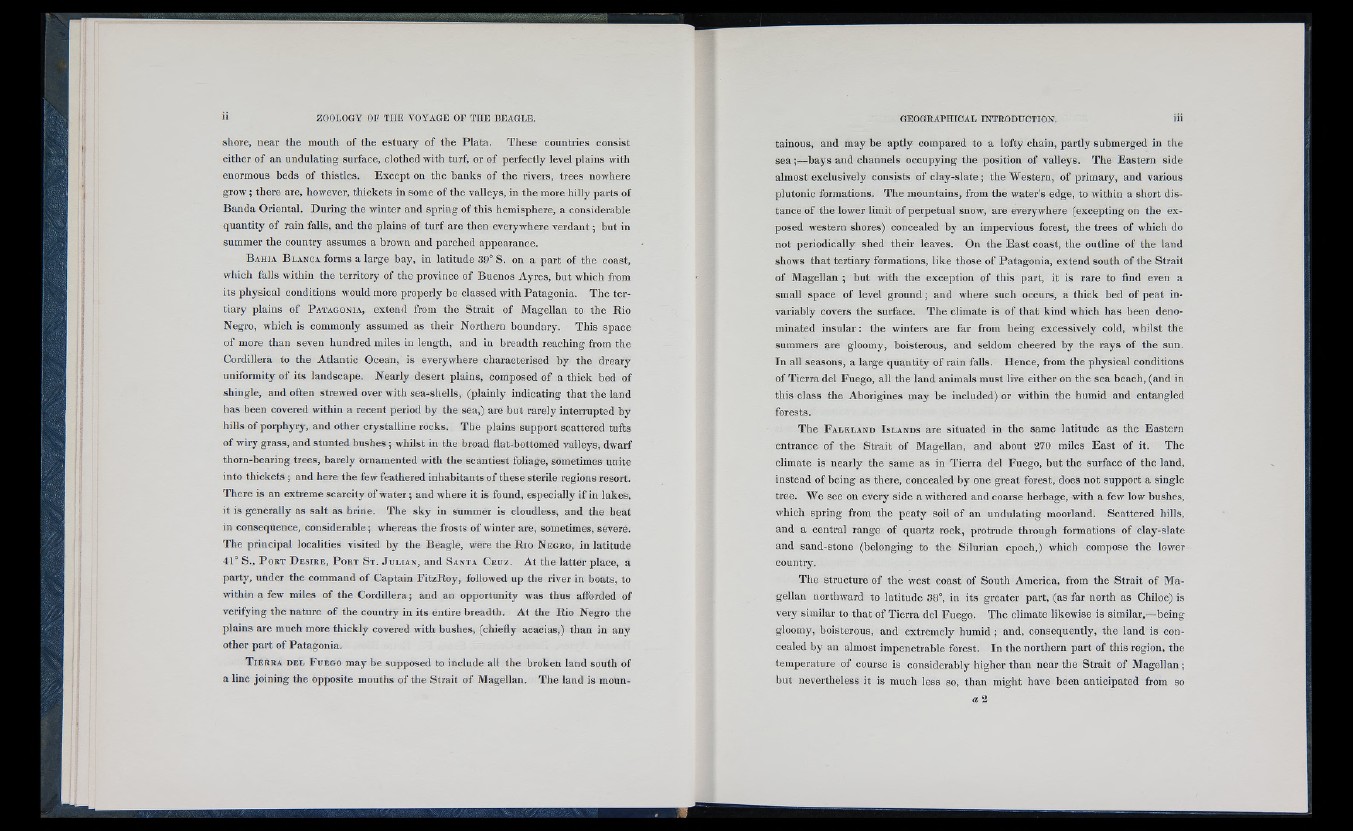
shore, near the mouth of the estuary of the Plata. These countries consist
either of an undulating surface, clothed with turf, or of perfectly level plains with
enormous beds of thistles. Except on the banks of the rivers, trees nowhere
grow; there are, however, thickets in some of the valleys, in the more hilly parts of
Banda Oriental. During the winter and spring of this hemisphere, a considerable
quantity of rain fails, and the plains of turf are tlien everywhere verdant; but in
summer the country assumes a brown and parched appearance.
B a h ia B l a n c a forms a large bay, in latitude 39° S. on a part of the coast,
which falls within the territory of the province of Buenos Ayres, but which from
its physical conditions would more properly be classed with Patagonia. The tertiary
plains of P a t a g o n ia , extend from the Strait of Magellan to the Rio
Negro, which is commonly assumed as their Northern boundary. This space
of more than seven hundred miles in length, and in breadth reaching from the
Cordillera to the Atlantic Ocean, is everywhere characterised by the dreary
uniformity of its landscape. Nearly desert plains, composed of a thick bed of
shingle, and often strewed over with sea-shells, (plainly indicating that the land
has been covered within a recent period by the sea,) are but rarely interrupted by
hills of porphyry, and other crystalline rocks. The plains support scattered tufts
of wiry grass, and stunted bushes; whilst in the broad flat-bottomed valleys, dwarf
thorn-bearing trees, barely ornamented with the scantiest foliage, sometimes unite
into thickets ; and here the few feathered inhabitants of these sterile regions resort.
There is an extreme scarcity of water; and where it is found, especially if in lakes,
it is generally as salt as brine. The sky in summer is cloudless, and the heat
in consequence, considerable; whereas the frosts of winter are, sometimes, severe.
The principal localities visited by the Beagle, were the Rio N e g r o , in latitude
4 1° S., P o r t D e s i r e , P o r t S t . J u l ia n , and S a n t a C r u z . At the latter place, a
party, under the command of Captain FitzRoy, followed up the river in boats, to
within a few miles of the Cordillera; and an opportunity was thus afforded of
verifying the nature of the country in its entire breadth. At the Rio Negro the
plains are much more thickly covered with bushes, (chiefly acacias,) than in any
other part of Patagonia.
T i e r r a d e l F u e g o may be supposed to include all the broken land south of
a line joining the opposite mouths of the Strait of Magellan. The land is mountainous,
and may be aptly compared to a lofty chain, partly submerged in the
sea;—hays and channels occupying the position of valleys. The Eastern side
almost exclusively consists of clay-slate; the Western, of primary, and various
plutonic formations. The mountains, from the water’s edge, to within a short distance
of the lower limit of perpetual snow, are everywhere (excepting on the exposed
western shores) concealed by an impervious forest, the trees of which do
not periodically shed their leaves. On the East coast, the outline of the land
shows that tertiary formations, like those of Patagonia, extend south of the Strait
of Magellan ; but with the exception of this part, it is rare to find even a
small space of level ground; and where such occurs, a thick bed of peat invariably
covers the surface. The climate is of that kind which has been denominated
insular: the winters are far from being excessively cold, whilst the
summers are gloomy, boisterous, and seldom cheered by the rays of the sun.
In all seasons, a large quantity of rain falls. Hence, from the physical conditions
of Tierra del Fuego, all the land animals must live either on the sea beach, (and in
this class the Aborigines may he included) or within the humid and entangled
forests.
The F a l k l a n d I s l a n d s are situated in the same latitude as the Eastern
entrance of the Strait of Magellan, and about 270 miles East of it. The
climate is nearly the same as in Tierra del Fuego, but the surface of the land,
instead of being as there, concealed by one great forest, does not support a single
tree. We see on every side a withered and coarse herbage, with a few low bushes,
which spring from the peaty soil of an undulating moorland. Scattered hills,
and a central range of quartz rock, protrude through formations of clay-slate
and sand-stone (belonging to the Silurian epoch,) which compose the lower
country.
The structure of the west coast of South America, from the Strait of Magellan
northward to latitude 38°, in its greater part, (as far north as Chiloe) is
very similar to that of Tierra del Fuego. The climate likewise is similar,—being-
gloomy, boisterous, and extremely humid; and, consequently, the land is concealed
by an almost impenetrable forest. In the northern part of this region, the
temperature of course is considerably higher than near the Strait of Magellan ;
but nevertheless it is much less so, than might have been anticipated from so
a 2